1625-0003_SS_r2_2012-sns-vis-bard-fr
1625-0003_SS_r2_2012-sns-vis-bard-fr.doc
Coast Guard Boating Accident Report Form (CG-3865)
OMB: 1625-0003
1625-0003
SUPPORTING STATEMENT
FOR
COAST GUARD BOATING ACCIDENT FORM (CG-3865)
OMB Control No.: 1625-0003
Collection Instrument: CG-3865
[as modified by USCG-2003-14963; RIN 1625-AB45]
A. Justification
1. Explain the circumstances that make the collection of information necessary. Identify any legal or administrative requirements that necessitate the collection. Attach a copy of the appropriate section of each statute and regulation mandating or authorizing the collection of information.
Title 46 USC 6102(a) requires a uniform marine casualty reporting system, with regulations prescribing casualties to be reported and the manner of reporting. The statute requires a State to compile and submit to the Secretary (delegated to the Coast Guard) reports, information, and statistics on casualties reported to the State. Implementing regulations are contained in Title 33, Code of Federal Regulations, Subchapter S - Boating Safety, Part 173 - Vessel Numbering And Casualty And Accident Reporting, Subpart C - Casualty and Accident Reporting, and Part 174 - State Numbering And Casualty Reporting Systems, Subpart C - Casualty Reporting System Requirements, and Subpart D - State reports.
The Federal regulations (33 CFR 173.55) require the operator of any vessel that is numbered or used for recreational purposes to submit an accident report to the State authority when:
(1) A person dies; or
A person is injured and requires medical treatment beyond first aid; or
Damage to the vessel and other property totals $2,000 or more, or there is a complete loss of the vessel; or
A person disappears from the vessel under circumstances that indicate death or injury.
The Coast Guard Boating Accident Report form (CG-3865, OMB control number 1625-0003) is the data collection instrument that ensures compliance with the implementing regulations and Title 46 USC 6102(b) that requires the Secretary to collect, analyze and publish reports, information, and statistics on marine casualties.
States are required to forward copies of the reports or electronically transmit accident report data to the Coast Guard within 30 days of their receipt of the report as prescribed by 33 CFR § 174.121 (Forwarding of casualty or accident reports). The accident report data and statistical information obtained from the reports submitted by the State reporting authorities are used by the Coast Guard in the compilation of national recreational boating accident statistics.
2. Indicate how, by whom, and for what purpose the information is to be used.
Accident data and statistical information1 received from the current collection are used by the Coast Guard to: establish National Recreational Boating Safety (RBS) Program goals, objectives, strategies and performance measures; report RBS Program performance to Congress in the USCG FY Performance Report and Budget in Brief; identify possible manufacturer defects in boats or equipment; develop boat manufacturing standards; develop safe boating education and accident prevention programs; and to publish accident statistics in accordance with Title 46 USC 6102. Non-receipt of the data and information from the public would require unnecessary additional investigation by the Coast Guard and communications with the persons who are required to file accident reports in compliance with Title 33 CFR 173.55. Further, many accidents would remain unreported with potential safety hazards going undetected. This would not be in the best interest of the public, State boating authorities or the Coast Guard.
The Coast Guard uses the information collected for four main purposes: regulatory studies, and non-regulatory studies, USCG Annual Report publication,2 and FOIA requests.
Examples of regulatory studies include a study to determine how many deaths and injuries could be prevented had the operator of a vessel worn a wireless lanyard. For this study, the Coast Guard focused on fields to determine the effectiveness of a lanyard including: accident description, prop strike, primary injury, cause of death, and accident type. Examples of non-regulatory studies include regional studies focused on topics such as nighttime boating or PFD wear rate on boat types, the latter of which required fields such as time of accident, day/night, accident type, type of boat, life jackets onboard, and life jackets accessible.
Every year the Boating Safety Division releases a statistics report on the prior year’s accident data. The report presents abstracted data gathered from boating accident reports on four broad topics: causes of accidents, accident types, casualty information, and operator/passenger information.
Information is shared internally in the Coast Guard. The two most frequent requestors of data are the Boating Safety Division and the Office of Performance Measurement and Assessment. Both of these offices request abstracted data, usually the number of accidents, deaths, and injuries during a specific time period. The Boating Safety Division uses this information to assess our progress with the program. The Office of Performance Measurement and Assessment uses this information for Coast Guard publications, often in the form of quarterly reports or forecasts.
There are other offices within the Coast Guard that have requested abstracted data on a number of topics including the number of incidents where flares cause fires on recreational boats and certain undocumented vessels, the number of accidents on salt vs. non-salt waters, and the number of accidents and casualties by Coast Guard District. These offices generally request data when prompted by a conference, publication, or media spotlight on a subject.
There are also requests from Coast Guard Auxiliarists for abstracted information or for a database of accident report data. Examples of abstracted information include the number of accidents, injuries, and deaths by state. Examples of a database request would be all 2007 accident data for the states in that Auxiliarist’s region. In general, Auxiliarists request information in preparation for a media interview.
The Boating Safety Division shares information with a number of external organizations including the National Association of State Boating Law Administrators, an association of state marine authorities, the National Boating Safety Advisory Council, is the Congressionally-mandated council that oversees the Boating Safety Division’s work, members from the marine and insurance industries, researchers, lawyers, recipients of non-profit grants, and the media.
If the Boating Safety Division receives permission to release data, information can be released in a number of ways depending on the scope of the request. Often times, databases, spreadsheets and documents are emailed. If they are too large, they are copied to a CD-ROM and mailed.
3. Describe whether, and to what extent, the collection of information involves the use of automated, electronic, mechanical, or other technological collection techniques or other forms of information technology, e.g., permitting electronic submission of responses, and the basis for the decision for adopting this means of collection.
There are two parts to the collection of data. Federal regulations are set up so that the public reports to the State and the State reports to the Coast Guard. The public can report by mail. All States report to the Coast Guard using the internet.
The Boating Accident Report Database (BARD-Web) System supports the Coast Guard’s implementation of a uniform vessel accident reporting system as required under Title 46 U.S.C, § 6102. Fully implementing BARD-Web reflects the Coast Guard’s commitment to data sharing by enabling local / State / Territory law enforcement officers to collect and electronically transfer accident report data to one central location via an Internet connection and a Web browser. BARD-Web is located at https://bard.cns-inc.com/ and enables: (1) State / local personnel to input casualty data at the accident scene; and (2) casualty data to be transformed into statistical information that is used to enhance the safety and security of the public using our nation’s waterways.
The following is a snapshot of the BARD log-in page.
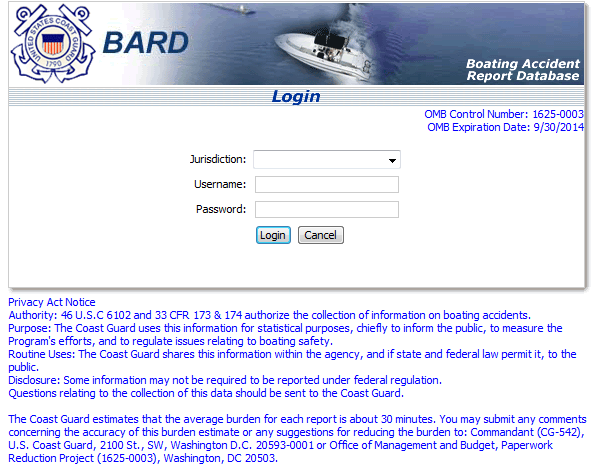
The following is a screenshot of a typical form entry page. The State representative would tab through fields and then select the tabs at the top of the screen to enter additional pertinent information.
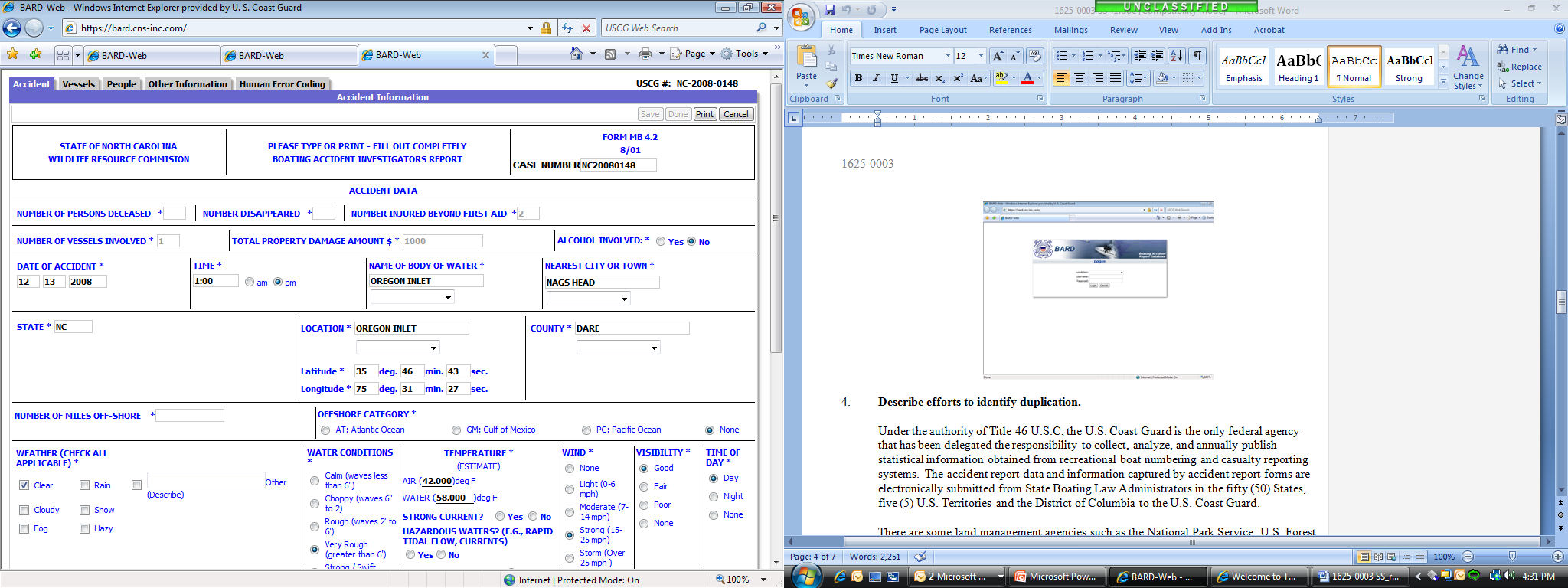
Records can be sorted by fields such as date, body of water, and county.
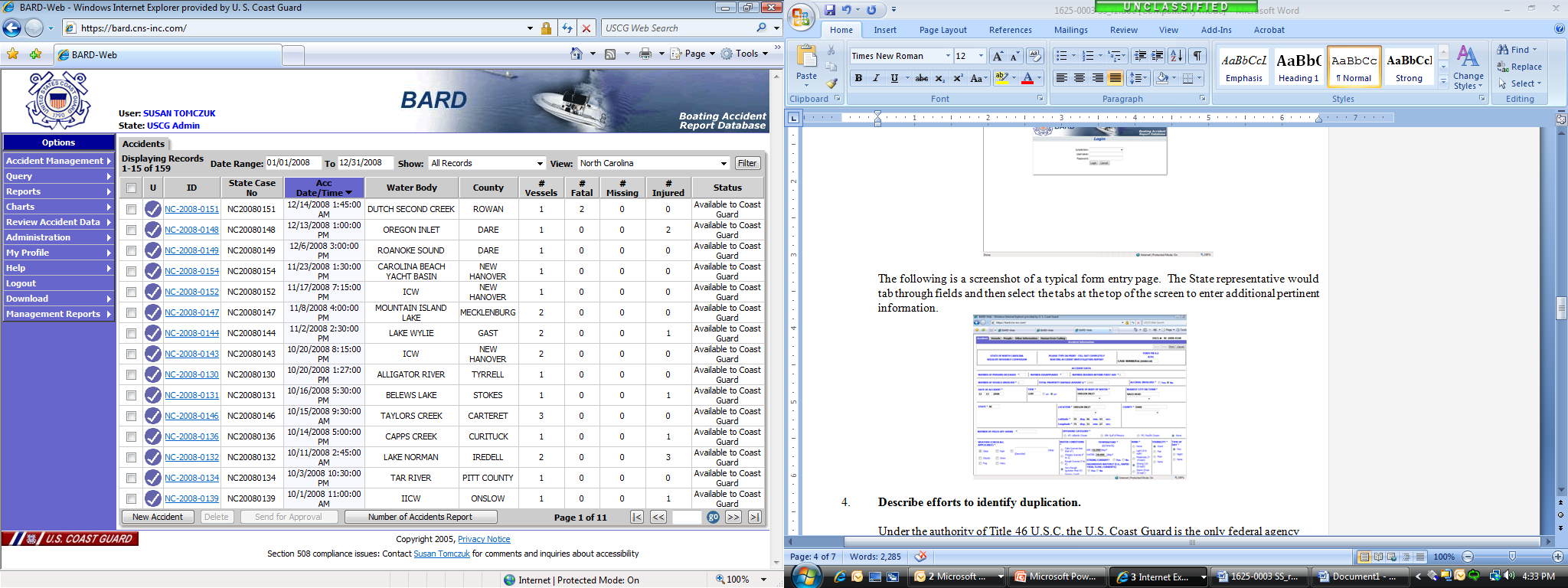
Users can query for data by using a query wizard.
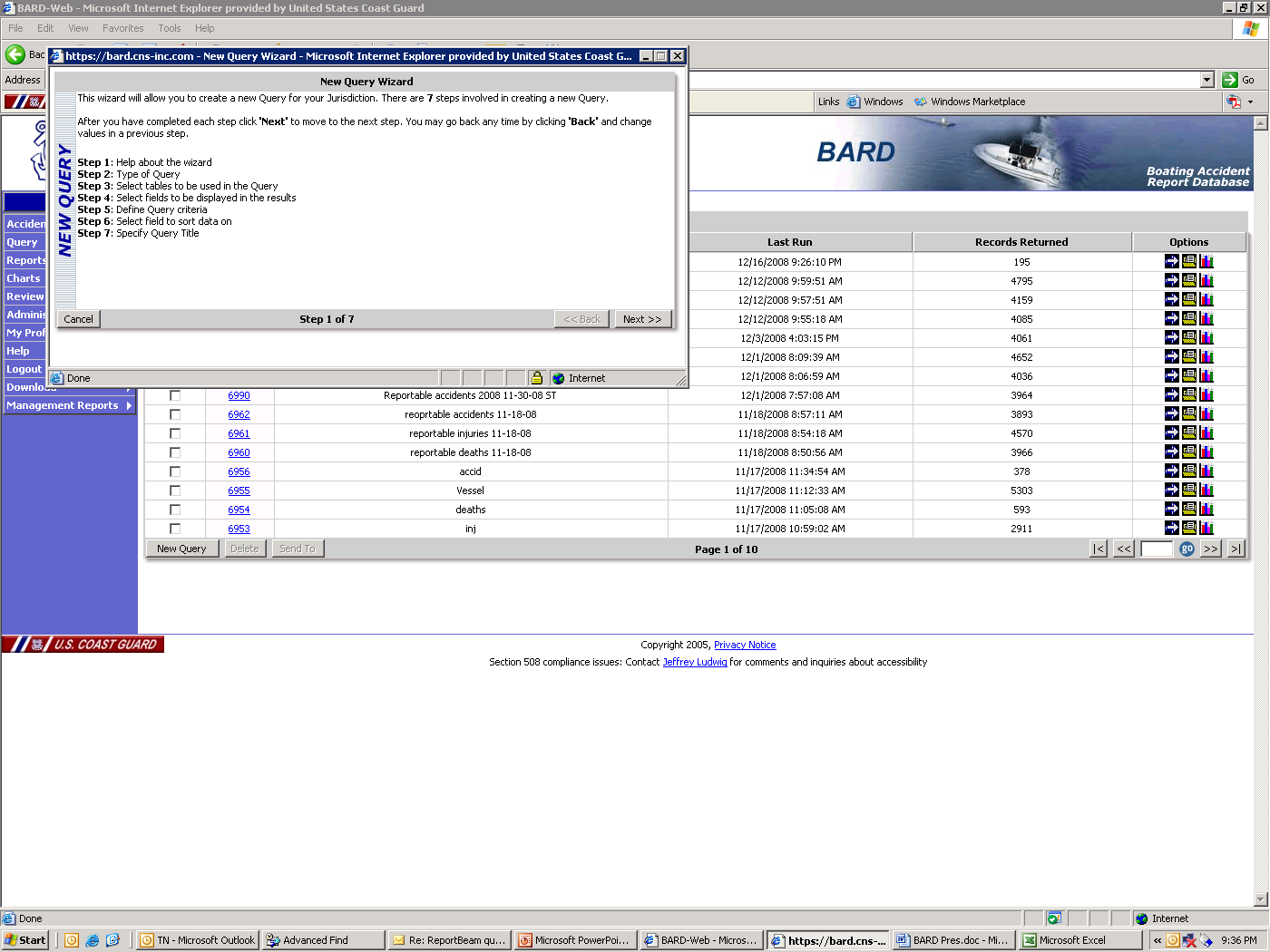
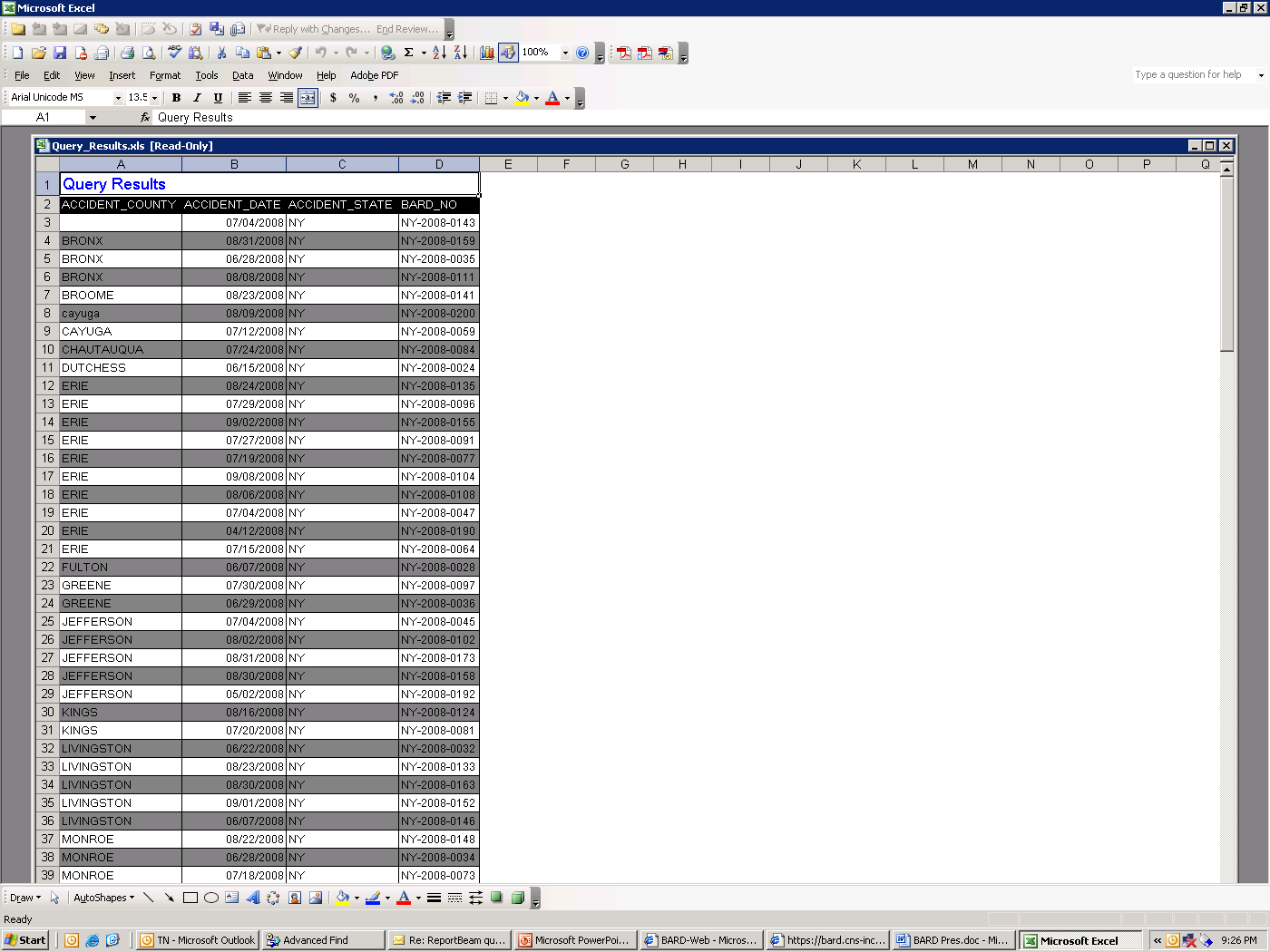
Users can also search for records by fields such as the name of operator, victim, owner, the date of accident, the name of body of water, vessel ID, hull identification number, and the case ID.

4. Describe efforts to identify duplication.
Under the authority of Title 46 U.S.C, the U.S. Coast Guard is the only federal agency that has been delegated the responsibility to collect, analyze, and annually publish statistical information obtained from recreational and certain undocumented vessel numbering and casualty reporting systems. The accident report data and information captured by accident report forms are electronically submitted from State Boating Law Administrators in the fifty (50) States, five (5) U.S. Territories and the District of Columbia to the U.S. Coast Guard.
There are some land management agencies such as the National Park Service, U.S. Forest Service and Army Corps of Engineers that have their own accident reporting systems. The Coast Guard works with these agencies to share data.
5. If the collection of information impacts small businesses or other small entities (Item 5 of OMB Form 83-I), describe any methods used to minimize burden.
There are no small businesses or other small entities involved in the collection of Federal Boating Accident Report forms. Form CG-3865 has been structured to require the minimum amount of information needed to accomplish statutory obligations and is filled out by individuals and/or State and local law enforcement officers.
6. Describe the consequence to Federal program or policy activities if the collection is not conducted or is conducted less frequently, as well as any technical or legal obstacles to reducing burden.
If the accident data and statistical information is not collected using Coast Guard form CG-3865, the mandated statutory requirement and implementing Federal regulations will not be met resulting in an unacceptable level of risk to the boating public. Thus, national RBS Program effectiveness would be significantly diminished in our ability to mitigate the risks associated with recreational boating activity.
7. Explain any special circumstances that would cause an information collection to be conducted in a manner:
The Coast Guard Boating Accident Report form is only filed upon the occurrence of a recreational boating accident that satisfies the Federal reporting requirements contained in Title 33 CFR 173.55.
8. Consultation.
The Coast Guard published on May 7, 2010, a Notice of Proposed Rulemaking (NPRM) entitled “Changes to Standard Numbering System, Vessel Identification System, and Boating Accident Report Database” (SNS-VIS-BARD) [USCG-2003-14963; RIN 1625-AB45; 75 FR 25137]. The rulemaking proposed—
to amend its rules related to numbering of undocumented vessels and reporting of casualties. These changes would align and modernize terminology used in the Standard Numbering System (SNS), the Vessel Identification System (VIS), and casualty reporting; require validation of vessel hull identification numbers; require SNS vessel owners to provide personally identifiable information; and provide administrative flexibility for States. Together, the proposed changes would improve recreational boating safety efforts, enhance law enforcement capabilities, advance maritime security, and clarify requirements for all stakeholders.
The Coast Guard received no collection of information-related comments to the NPRM.
On March 28, 2012. the SNS-VIS-BARD Final Rule was published (77 FR 18689).
9. Explain any decision to provide any payment or gift to respondents, other than remuneration of contractors or grantees.
There is no offer of monetary or material value for this information collection.
10. Describe any assurance of confidentiality provided to respondents and the basis for the assurance in statute, regulation, or agency policy.
There are no assurances of confidentiality provided to the respondents for this information collection. The system’s Privacy Impact Assessment was published 12 November 2009, and is maintained and managed accordingly. BARD’s SORN status is under review by the Coast Guard Privacy Office; staff are determining whether BARD can be included in a current SORN such as the one for the Marine Information for Safety and Law Enforcement (MISLE). Further, under Title 46, U.S.C. § 6102 (b), if a State marine casualty reporting system provides that information derived from casualty reports (except statistical information) may not be publicly disclosed, or otherwise prohibits use by the State or any person in any action or proceeding against a person, the Secretary may use the information provided by the State only in the same way that the State may use the information.
11. Provide additional justification for any questions of a sensitive nature, such as sexual behavior and attitudes, religious beliefs, and other matters that are commonly considered private.
There are no questions of sensitive nature.
Provide estimates of the hour burden of the collection of information.
The estimated number of respondents is 56. There is an estimated 35-minute burden (.583 hours) to a respondent for each report filed for an annual estimated burden of 2,970 hours for the estimated 5,094 reports.
5,094 reports X .583 hours = 2,970 hours
-
ANNUAL BURDEN HOURS
Number of respondents:
56
Number of responses:
5,094
Time to complete in hours:
.583
Total Annual Burden Hours:
(5,094) X (0.583 hrs) = 2,970 hrs
13. Provide an estimate of the total annual cost burden to respondents or record keepers resulting from the collection of information. (Do not include the cost of any hour burden shown in Items 12 and 14).
The cost to the general public to mail a Coast Guard CG-3865 form in 2006 is 44 cents. On an annual basis, the approximate cost to the general public to mail 5,000 forms to the appropriate State reporting authority as prescribed in Title 33 CFR 173 is $2,200 (5,000 x 44 cents).
-
ANNUAL COST BURDEN TO RESPONDENTS
Number of respondents:
56
Number of responses:
5,094
Cost to mail 1 report:
44 cents or $ 0.44
Total Annual Cost Burden:
(5,094) X (0.44) = $2,241
14. Provide estimates of annualized cost to the Federal government.
The estimated annualized cost to the Federal government to administer and maintain the fully implemented electronic National Boating Accident Report Database (BARD) System for the fifty (50) States, five (5) U.S. Territories and the District of Columbia is approximately $400,000.3 These costs include providing BARD System maintenance, help desk support, formal training, and implementing system enhancements in response to evolving/changing user requirements in the fifty (56) reporting jurisdictions.
15. Explain the reasons for any program changes or adjustments reporting in Items 13 or 14 of the OMB Form 83-I.
First, the change (i.e., increase) in hour burden is a PROGRAM CHANGE due to the SNS-VIS-BARD rulemaking [USCG-2003-14963; RIN 1625-AB45]. The changes to the reporting requirements are as follows—
Two information elements were dropped from the current 33 CFR 173.57(w) reporting requirements. Those were “beam width at widest point” and “depth from transom to keel”. It is proposed that it is no longer necessary to collect those two elements of information.
Terms found in 33 CFR 173.57(w) to describe characteristics of the boat were modified to align with the terms used in 33 CFR 187.103 “What information must be collected to identify a vessel?”.
The seven terms found in 33 CFR 173.57(u) type of vessel operation were simplified to “maintaining course and speed”, “changing course” or “changing speed”.
The seven terms previously found in 33 CFR 173.57(u) as “type of vessel operation” were converted to “activity at time of incident”, and an additional 15 descriptive terms were added.
An additional term for “engine drive type” was added.
The above changes result in a change in response time from 30-minutes to 35-minutes per report.
Second, the methodology for calculating burden remains unchanged.
16. For collections of information whose results will be published, outline plans for tabulation, and publication.
Reports are reviewed on an ongoing basis. Within five months of the end of the calendar year, the Coast Guard’s annual Boating Statistics report (COMDTPUB P16754)4 will be published. The annual boating accident statistics report is based on accident reports submitted to State reporting authorities that are entered into the BARD System. COMDTPUB P16754 provides general descriptive statistics about the causes and conditions of accidents, the types of accidents, operator/passenger information and casualty information.
17. If seeking approval to not display the expiration date for OMB approval of the information collection, explain the reasons that display would be inappropriate.
USCG will display the expiration date for OMB approval of this information collection.
18. Explain each exception to the certification statement identified in Item 19, "Certification for Paperwork Reduction Act Submission," of OMB 83-I.
USCG does not request an exception to the certification of this information collection.
1 In this context, statistical information is the complilation of boating accident data.
2 Every year, the U.S. Coast Guard compiles statistics on reported recreational boating accidents. These statistics are derived from accident reports that are filed by the owners / operators of recreational vessels involved in accidents. The fifty states, five U.S. territories and the District of Columbia submit accident report data to the Coast Guard for inclusion in the annual Boating Statistics publication. The latest Boating Statistics publications are available-- http://www.uscgboating.org/statistics/accident_statistics.aspx
3 The $400,000 cost is the annual cost of the contract for maintaining BARD.
4 The latest Boating Statistics publications are available-- http://www.uscgboating.org/statistics/accident_statistics.aspx
| File Type | application/msword |
| File Title | SUPPORTING STATEMENT FOR |
| Author | TSA Standard PC User |
| Last Modified By | David A. Du Pont |
| File Modified | 2012-04-02 |
| File Created | 2012-04-02 |
© 2025 OMB.report | Privacy Policy